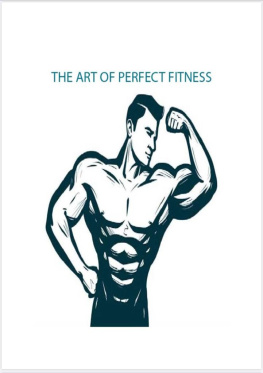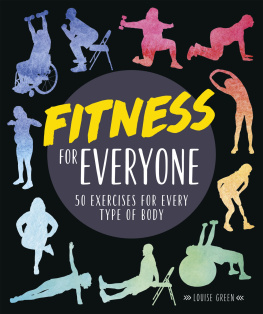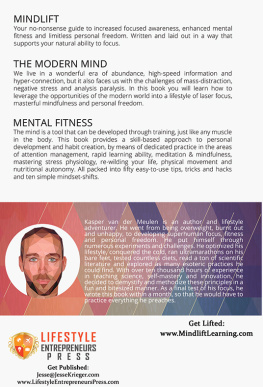
THE AGE OF FITNESS
HOW THE BODY CAME TO SYMBOLIZE SUCCESS AND ACHIEVEMENT
JRGEN MARTSCHUKAT
TRANSLATED BY ALEX SKINNER
polity
Originally published in German as Das Zeitalter der Fitness. Copyright 2019 S. Fischer Verlag GmbH, Frankfurt am Main
This English edition 2021 by Polity Press
Polity Press
65 Bridge Street
Cambridge CB2 1UR, UK
Polity Press
101 Station Landing
Suite 300
Medford, MA 02155, USA
All rights reserved. Except for the quotation of short passages for the purpose of criticism and review, no part of this publication may be reproduced, stored in a retrieval system or transmitted, in any form or by any means, electronic, mechanical, photocopying, recording or otherwise, without the prior permission of the publisher.
Front cover of Cosmopolitan (UK) reproduced with permission from Hearst Magazines UK
Ben Watts/Courtesy Hearst Magazines UK
ISBN-13: 978-1-5095-4565-0
A catalogue record for this book is available from the British Library.
Library of Congress Cataloging-in-Publication Data
Names: Martschukat, Jrgen, author. | Skinner, Alex, translator.
Title: The age of fitness : how the body came to symbolize success and achievement / Jrgen Martschukat ; translated by Alex Skinner.
Other titles: Zeitalter der Fitness. English
Description: Medford : Polity Press, 2021. | Includes bibliographical references and index. | Summary: Why the pursuit of fitness has become a central preoccupation of modern life-- Provided by publisher.
Identifiers: LCCN 2020033791 (print) | LCCN 2020033792 (ebook) | ISBN 9781509545636 (hardback) | ISBN 9781509545650 (epub)
Subjects: LCSH: Body image. | Physical fitness. | Success. | Performance.
Classification: LCC BF697.5.B63 M37713 2021 (print) | LCC BF697.5.B63 (ebook) | DDC 306.4/613--dc23
LC record available at https://lccn.loc.gov/2020033791
LC ebook record available at https://lccn.loc.gov/2020033792
The publisher has used its best endeavours to ensure that the URLs for external websites referred to in this book are correct and active at the time of going to press. However, the publisher has no responsibility for the websites and can make no guarantee that a site will remain live or that the content is or will remain appropriate.
Every effort has been made to trace all copyright holders, but if any have been overlooked the publisher will be pleased to include any necessary credits in any subsequent reprint or edition.
For further information on Polity, visit our website: politybooks.com
ACKNOWLEDGMENTS
This book took shape over many years and in the context of a number of research projects. Between 2012 and 2015, the Fritz Thyssen Foundation funded our project on Das essende Subjekt (The Eating Subject). I am as indebted to that institution as I am to the Volkswagen Foundation for generously funding the project on Ernhrung, Gesundheit und soziale Ordnung in der Moderne: Deutschland und die USA (Nutrition, Health, and Social Order in Modernity: Germany and the United States) from 2015 to 2019, as part of the funding stream Schlsselthemen fr Wissenschaft und Gesellschaft (Key Issues for Science and Society). Without the research professorship that formed part of this key issues project in the summer semester of 2018, I would not have been able to complete this book.
While working on the manuscript I received valuable feedback from numerous colleagues and friends. The North American History colloquium at the University of Erfurt and various seminars, from Charlottesville in Virginia to Dunedin in New Zealand, were a great source of inspiration. Through a William Evans Fellowship in the spring of 2017, the University of Otago enabled me to carry out research at its School of Physical Education, Sport and Exercise Sciences, which in turn allowed me to discuss the project intensively and advance it greatly. My thanks go to Doug Booth for his tremendous support, his wonderful hospitality, and his input at various workshops and over numerous coffees. My thanks also go to Stefanie Bttner, Katharina Dahl, Paula Dahl, Tristan Dohnt, Norbert Finzsch, Laura-Elena Keck, Tae-Jun Kim, Olaf von dem Knesebeck, Nina Mackert, Irene Martschukat, Maren Mhring, Stefan Offermann, Tanja Robnik, Olaf Stieglitz, Heiko Stoff, Paula-Irene Villa and Simon Wendt, who read various parts and versions of the text and discussed them with me. Paula Dahl, Nina Mackert and Irene Martschukat even worked their way through the entire manuscript; Maria Matthes and Viviann Wilmot assisted me with the research and the final editing, and Alex Skinner created an elegant translation. Without your help this project would have gotten nowhere.
Last but not least, my special thanks to Alex, Andy, Bille, Dirk, Flo, Harry, Jrg, Matthias, Paddy, Reemt, Sebastian, Silke and all the other boys and girls from Team Altona for their company across thousands of kilometers in and around Hamburg and throughout Europe.
INTRODUCTION: THE AGE OF FITNESS
We live in the age of fitness. Tens of thousands of people run marathons and compete in all-comers cycle races, while millions go for an evening jog in the park or work out in gyms, where they lift weights and use machines of various kinds or practice yoga; active vacations of all kinds are more popular than ever. In 1970, this was barely conceivable. Hiking vacations were for retirees and windsurfing had just been invented. The Berlin Marathon still lay in the future. Few adults had a bicycle, while gyms were few and far between. Since then, however, fitness has boomed. Lets consider the scale of the fitness market. In Germany alone, active people (and those who want to appear active, or at least aspire to be active) spent over 50 billion euros on fitness-related items in 2015: running shoes and sportswear, weights and carbon fiber bicycles, energy drinks and diet foods. Equally popular are fitness classes and activity vacations, fitness magazines and books, apps and gadgets. Fitness stars such as Kayla Itsines to mention one of many examples have millions of followers on Instagram; images of toned bodies are hugely popular on social media.
What those engaged in getting fit generally have in common is that they are active, but rarely organize themselves in clubs or associations. They do not participate in a specific league, and they are almost never out to win a competition. Yet they all want to improve themselves somehow. They do not engage in the kind of organized competitive sport that spread from the United Kingdom to other modernizing societies from the mid-nineteenth century. Those who undertake fitness training are not looking to win a medal. Instead, what this practice aims to achieve is a fit body. This body, in turn, stands for an array of partially overlapping forces, abilities and ideals, which point far beyond the doing of sport. These encompass ones health and performance in everyday life and at work, productivity and the ability to cope with challenging situations, potency, a slim figure and a pleasing appearance according to the prevalent standards of beauty. Also important in this context is doing the right thing, doing something good for oneself, and getting the best out of oneself, as well as gaining recognition for it. At times, the sheer joy of movement and activity also comes into play. These various driving forces are not mutually exclusive.
The pursuit of fitness A so-called sedentary lifestyle and an unhealthy, high-calorie diet are viewed as the main causes of increasing fatness. On the one hand, then, there is a culture of fitness, while on the other there is anxiety over the lack of exercise and burgeoning fatness. What may seem contradictory at first sight turns out to be part of a single social formation, centered on the self-responsible, committed and productive individual. Both sides of this coin (the culture of fitness and the fear of fat) revolve around the successful self, which proves its success by mastering its own body. In (post)modern societies, lack of fitness amounts to a flashing red light.
Next page









